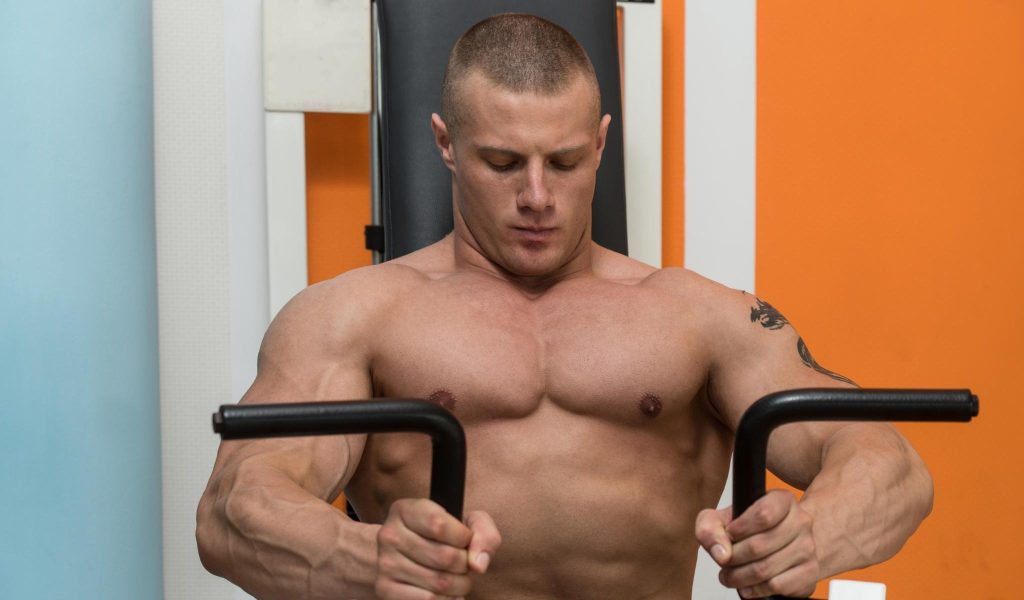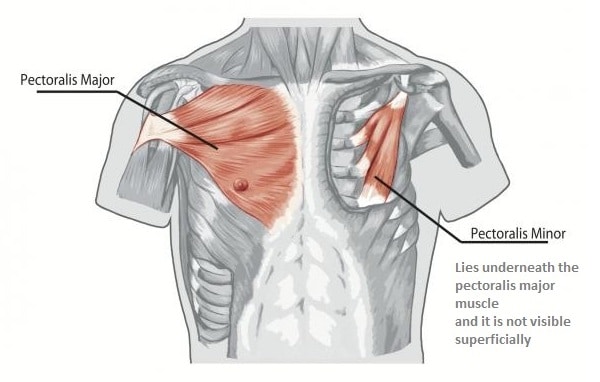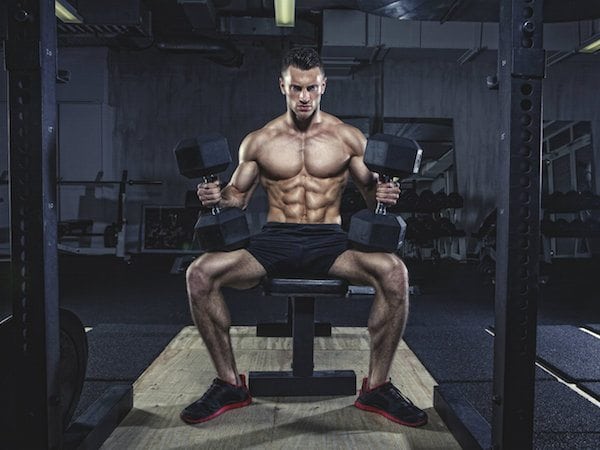No products in the cart.
Boost The Size Of Your Chest : Tips For A Larger Chest

When you look at bodybuilders, one of the first things you notice is the size of their chest, but how do bodybuilders get their chests built up so quickly?
If you want to become more muscular and more aesthetically pleasing to the eye then you will need to find a way to build up your chest muscles.
While there is no real shortcut, there are certainly right and wrong ways to achieve your goal.
Here are some quick tips that you should consider when you’re boosting the size of your chest.[toc]
Anatomy of the Chest Muscles

First off, you need to understand how the chest works.
The chest has two main muscles known as the pectoralis major and minor. These two muscles work together to help move your arm in three main directions; down, inward and ahead.
The chest is your centre. So even if you’re looking to build up other parts of your body, you want to make sure that your chest is ready to go as well.
You want to make sure that you don’t make the common mistakes that people make while they’re training their chest area.
For example, training your chest muscles four times a week while using dead weights is a waste of time, particularly if you are thin.
You can’t make your chest bigger with standard weights or utilising activities like dumbbell swings.
Training your chest, even if you’re doing it three or four times a week, won’t make it larger unless you consume more nutritious food, particularly protein.
Lastly, although your chest has two principle heads. It is still all one muscle and contracts together. You can’t detach your upper or lower chest, you need to focus on the entire thing.
Diet For A Larger Chest
The way to increase the size of your chest muscles is to consume more and to get stronger.
As we mentioned above, your chest will never get large when you’re underweight.
To put on weight, you will have to consume food at regular intervals and concentrate on increasing your daily calorie intake.
While your workout is obviously an important part of the muscle building process, your diet is probably even more important.
Without adequate nutrition (read our bulking guide for a more in-depth article) you will not be providing the building blocks your body need to build that lean muscle.
For a start, you will need to ensure you are consuming enough protein.
Experts agree that you should consume at least 1 gram of protein for every pound you weigh. This will give you the nutrients required to repair and grow new muscle tissue.
Some of the best sources of protein are:
- Lean beef
- Turkey
- Chicken
- Fish
- Beans
- Dairy (Milk, eggs, cheese, yoghurt etc)
- Nuts
- Protein powder
You will also need to look at your intake of carbohydrates too. This is what will provide you with the energy required to work out to your max.
I would suggest choosing complex low GI carbs such as:
- Oatmeal
- Brown rice
- Sweet potatoes
The reason for this is that simple carbs (white flour and white rice) will not provide you with adequate energy, and will leave you feeling sluggish during your workout.
As well as protein and carbs, your body also needs fat to function. It is a key component of muscle building, fat loss and heart health.
This does not mean that you should be eating junk food though, this is not the kind of fat I am talking about.
You should instead try to eat more food that contains healthy fats such as omega-3 fats. These can be found in the following foods:
- Fish
- Olive oil
- Avocado
- Nuts
The final advice when it comes to your diet is to ensure you are eating at the correct times for your needs.
For example, if you have just completed an intense workout then your body will probably be crying out for nutrients.
This is the perfect time to start off the process of repair and growth. So eat a meal full of protein and carbs.
If you fail to do so then your body may go into a catabolic state, which is not something that you will want to occur if your aim is to build muscle.
When you enter a catabolic stage your body will start to break down muscle tissue for energy.
My advice would be to eat within an hour of finishing your workout and to grab a protein shake if you do not have time to eat.
Best Exercises for Chest
You want to make sure that you’re pushing yourself hard when you’re trying to increase the size of your chest.
Free weight compound activities like the squat, the deadlift, bench presses and overhead presses are the quickest approach to develop overall muscle quality and mass.
Do them regularly and push yourself as hard as you can without hurting yourself.
As you can tell, these particular exercises will also help train your legs. As your legs get stronger, it will help to produce the growth hormones. This will, in turn, help boost your chest.
Focus on these activities with free weights, and alternate with some machine work.
While the bench press is a fantastic exercise for chest, shoulder, and tricep developments it is not the only exercise option available for your chest.
To build muscle in your chest there are other things you can do, here 4 exercises that will explode your chest, and none of them involve bench pressing:
Exercise #1: The Push Up
The push up is the go-to test of strength for men across the planet.
When you’re at school you’ll do them in most gym classes. When you participate in sport they’re always added to your training sessions, and if you attend boot camp you’ll probably perform about 15 different variations of them. But for some reason when it comes to your own training, push-ups are strangely absent.
Maybe this is because push-ups bring back bad memories. Or because the fact that you did them at school makes them seem less legit as an exercise.
Well whatever reason you have for ignoring them please stop, because push-ups are one of the most versatile chest exercises there are!
You can perform regular push-ups to improve endurance and hypertrophy, you can perform weighted push-ups to increase strength, or you can try explosive push-ups for power.
Then there are close grip push-ups that prioritise triceps. Hindu push-ups that place the emphasis on the shoulders, or wide grip push-ups to target the chest more. You can also perform push-ups as part of HIIT and improve your cardio.
There are so many different ways that you can train the chest. And hardly any of them require equipment or a lot of space.
Also, push-ups are invariably harder than you remember them to be.
Whatever number of reps you guess you can hit, subtract 20% because push-ups will surprise you.
Exercise #2: The Dip
The dip is a great exercise for strengthening the chest and triceps. In fact, a lot of experts believe that the dip is a better exercise than the bench press for pectoral stimulation
The dip is not as popular with lifters though because it is a less accessible exercise.
For one thing, you need a dip machine to perform them, and these aren’t always available. Either because your gym is garbage or because there’s a line of 9 guys waiting for their turn around the single dip bar station.
Another reason that dips are not accessible is that they are difficult!
Just like pull-ups you need to be strong enough to lift your own bodyweight. This means that some bodybuilders or powerlifters would struggle.
Even a strong guy who has a good muscle to bodyweight ratio might struggle to hit the high rep range needed for hypertrophy.
Luckily there are ways around this, a lot of gyms now have assisted dip machines. Which are great for beginners or for experienced lifters who are looking to perform a high rep set after 4 sets of proper dips.
You can also create your own version by attaching a resistance band around the handles before placing your knees on them.
Exercise #3: Chest Press Machine
The chest press machine is not a bench press. Though of all the exercises here this one feels the most like cheating.
Chest press machines differ from bench presses in two ways. Firstly, they are set up so that you are upright and sitting down rather than lying down. Secondly, they are a fixed-resistance machine whilst bench presses are free-weight.
Other than that they are very similar in design. However, the chest press does have some advantages over the bench. For starters, it is a lot easier to change weights.
This makes chest presses ideal for drop sets or back offsets where the weight needs to be lowered quite fast (and often) between sets.
The second advantage they have is that they don’t require the same level of balance or technique. In many ways, these are disadvantages, because it means that fewer muscle fibres will be activated and the hormonal response will be lessened.
However, if you’re already fatigued or if you are new to the gym having a simple movement to perform means that you will get a better quality of workout with less chance of injury.
Exercise #4: The Chest Fly
The chest fly is a great chest exercise because it exclusively works the pectoral muscles. This means that there is no real stimulation of the shoulders or triceps. This makes flys an excellent choice post-bench press (or post any of the 3 previous exercises).
The chest fly is unique in its movement pattern. This is because it stretches the pecs further than any other exercise. Meaning more muscle fibres are recruited.
This will lead to increased muscle protein synthesis, which means more strength and hypertrophy.
Tips for Growing Chest Muscles
The following are some tips you should follow for a larger and more muscular chest:
#1: Make Sure You Get Plenty Of Rest
One of the biggest mistakes that bodybuilders make is that they don’t rest enough. Your muscles develop when they rest, not when you are training.
At the most, you want to do intense training about two times a week. Three at the absolute most.
Consume the appropriate calories so your chest gets the supplements it needs to recuperate and develop. That way, you’ll start to see the changes in the recovery time, and you will start to bulk up more easily.
#2: Check Your Form
Another important thing that you need to consider when boosting your chest size is how you’re doing your exercises.
A partial bench press doesn’t work your chest through a full extent of movement. Touch your shirt on the path down and straighten your elbows at the top.
Lower the weight as slowly as you can under control and then lift as quickly as you can on the way up for the best results.
#3: Give 100% Intensity

If you are not working out to your maximum intensity then don’t moan that you are not seeing the results you want to see.
Your body responds to the effort that you put in. So if you give 100% then your muscles will have to work, leading to increases in both size and strength.
To help boost your intensity levels I would suggest using a spotter and to listen to the right kinds of music.
Using a spotter will allow you to lift heavy without having to worry about getting stuck under the bar.
Not only will they ensure you do not get stuck but they can observe your form while also helping to encourage you through those last few reps.
Up-tempo music can help you to lift that much more. It’s no good listening to something relaxing, you need something to get you pumped up.
#4: Focus On Your Goals
In any sort of training, you want to make sure that you’re focusing on your goals.
You should remember though that regardless of how you prepare and whether you consume the same as your idols, you’ll never get the same muscle shape.
When you build your muscles, you have to focus on YOUR training and diet.
In any case, the state of your muscles is hereditary and because of that, you will have to be patient while you’re training. Particularly in case you’re still an adolescent.
Your body is still in development and you won’t get the chest improvement of a young adult if you’re still just a teenager. Your chest will change as you push forward and grow older.
In Conclusion
Hopefully, these few tips will help you get the chest you want. There is no real secret, but if you stick to the basics you will soon start to see the rewards for yourself.
Save
Save
